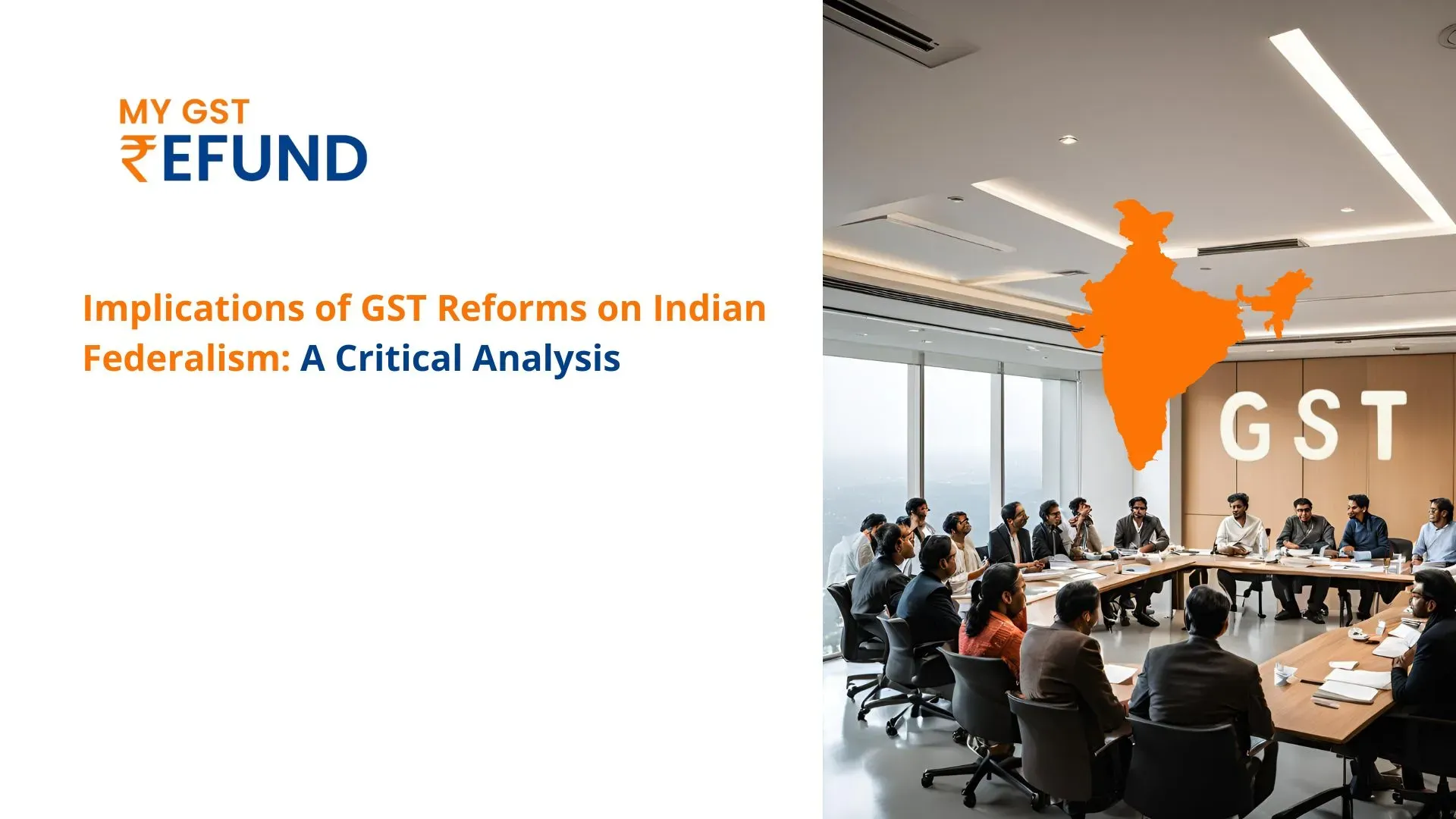Implications of GST Reforms on Indian Federalism: A Critical Analysis
The Goods and Services Tax (commonly known as GST) was introduced on 1st July 2017 and this was an event of historic significance, especially in the tax environment of the country since it unified multiple indirect taxes into one tax system. As it is on every system, the GST system is credited with easing tax administration, aiding in the creation of a single market, and increasing tax compliance among the concerned parties. However, bringing the GST system into place has also created a lot of issues that are pertinent in the context of Indian federalism because taxation powers are one of the core aspects of any federal state. This article presents an assessment of the GST reforms on Indian federalism and examines how the new taxation regime has either encouraged or mitigated the trends towards centralization and state autonomy.
Historical Context of Fiscal Federalism in India
The constitution of India also depicts the federal structure of governance, where it specifies the powers and responsibilities of the Centre and the states. Although the state governments have been vested with a variety of powers under such arrangements, one of the notable such powers has been the ability to tax goods and services within their geographical areas.Important taxes such as value-added tax (VAT), entertainment Tax and state excise constituted a substantial part of the revenue collected by the states, thereby allowing some degree of fiscal independence to the states in designing and managing their tax systems.
The Center on the other hand had authority over direct taxes such as income and corporate taxes, apart from customs and excise of various goods. The introduction of GST, comprehensive indirect tax levied uniformly throughout the country, completely changed the equation.
Centralization of Fiscal Powers
With respect to the impact of GST reform on the federal structure prevailing in India, one of the most pertinent aspects is the encroachment of fiscal power at the core. GST replaced multiple state and central taxes, pooling them under a unified tax regime governed by the GST Council, which consists of the representatives of the center and the states and which decides the tax rate, the exemption limits and the general structure. Although the council provides for input from the states in decision-making, the overall trend has been towards a unitary form of tax, which has weakened the financial powers of the states.
Loss of Independent Taxation Powers:
Before the implementation of Goods and Services Tax (GST), it was possible for the states to modify the VAT rate in accordance with their economic needs. However, after the GST regime, this flexibility has been taken away, diminishing the ability of the states to meet their local financial needs. While a uniform tax regime helps in improving the business environment, it has restricted the states from raising and voicing their concerns independently through the sales tax and other indirect taxes.
Uniformity versus Differences:
The economy of India is composed of different states, which as a result influences the economic profile and the level of development of each state. When it comes to the application of GST, the ‘one size fits all’ approach is unlikely to address the fiscal needs of all the states. Progressive states such as Maharashtra or Gujarat, which possess well-developed industries, may benefit from lower GST rates rather than poorer or less progressive states, which may require higher rates or a different tax for revenue collection.
The Role of the GST Council: Cooperation or Coercion?
The creation of the GST Council has been seen as a collaborative step toward ensuring joint decision-making between the Centre and states. However, the functioning of the GST Council has revealed tensions in Indian federalism.
Fair Representation or Unequal Distribution of Power?
Although the GST Council includes the Finance Ministers of the States and some Central Ministers, it is not an equal voting structure. One-third of the votes are allocated to the Center, and in order to pass any motion, a three-fourths majority is required. This pragmatically suggests that the central government is in a position to dominate any settler's decision, highlighting the possibility of states being forced to implement unsought policies.
Compensation Issues:
Due to apprehensions regarding revenue losses as a result of the changeover to GST, the central government assured the states of compensation for a period of five years. However, delays in the payment of compensations resulted in friction between the Center and the states, where the states accused the Center of not honoring its promise. This strain, however, is indicative of the problems inherent in the maintenance of financial discipline in any system that is essentially centralised.
Impact on State Finance and Autonomy
Loss of Revenue for States:
Many states have significantly suffered revenue losses under GST, especially in particular sectors such as manufacturing, which used to be high revenue contributing sectors in the VAT regime. Manufacturing heavy states like Tamil Nadu and Maharashtra are apprehensive of the fact that GST has favored consumption states more than them. The assurance of compensation has eased these worries to some extent, but the eventual discontinuation of compensation will leave some states financially vulnerable
Borrowing and Fiscal Discipline:
The imposition of Goods and Services Tax (GST) on state revenues has also made it difficult for them to fulfill their borrowing and fiscal obligations. Due to the few avenues of self-generating revenue, states have become dependent on the Center, thus undermining the federalism equilibrium.
Cooperation vs. Competition: The Changing Nature of Federalism
The introduction of GST has resulted in increased inter-state cooperation thanks to the creation of a common market without tax barriers and eliminating the cascading effect of taxes. Yet, it has also increased the level of competition between the states. States have to persuade investors in a better way by enhancing the quality of infrastructure and cutting down the compliance costs rather than changing tax rates as they were before the introduction of GST.
- Authorities would strive hard to attract foreign investment by offering businesses’ competitive VAT rates, and this was the case with the previous system. The introduction of the standardised GST system across all states has done away with that type of competition and, in effect, may limit the states’ ability to woo investors and encourage growth. As a result, states now emphasize non-fiscal measures, such as improving infrastructure and reducing regulatory hurdles.
The Way Forward: Balancing Centralization and State Autonomy
GST has undoubtedly facilitated the practice of business in India and made easier tax compliance as well, however, its impact on federalism is not as clear-cut. The challenge is that of centralization versus state autonomy. Potential measures could be.
Enhancing the Federal Architecture of the GST Council:
Though the GST Council facilitates federalism, there is a need to empower states with an adequate share of vote in order to address their grievances.
Timely Compensation and Transfers:
Apart from getting the fiscal deficit vying for, any revenue losses suffered by states should be compensated for promptly by the Center.
House Tax Introductions:
The policy of having the same GST tax rates in a member state is a policy that should be reviewed due to the lower revenue base of some of the member states. This may in turn lead to some counties, for example, in the tourism sector, being allowed to levy extra charges to make up for some of the revenues lost.
Conclusion:
GST reforms have brought a major transformation in the taxation system of India to be more effective and uniform. But at the same time, it has also been a case of more centralization in the fiscal powers, which has affected the federal structure between the Center and the states. Although the GST Council attempts to mitigate the effects of such measures, there are risks related to shrinking state autonomy, lack of revenue, and unequal power in decision-making. For the sake of Indian federalism, it is important to see that some fiscal space is provided to the states while reaping the rewards of a common market. Confronting these challenges will be imperative in ensuring that the vision of GST remains applicable to the complexities of India’s federal structure over time.
Also Read : Brief history of GST:India and the world
Related Posts








